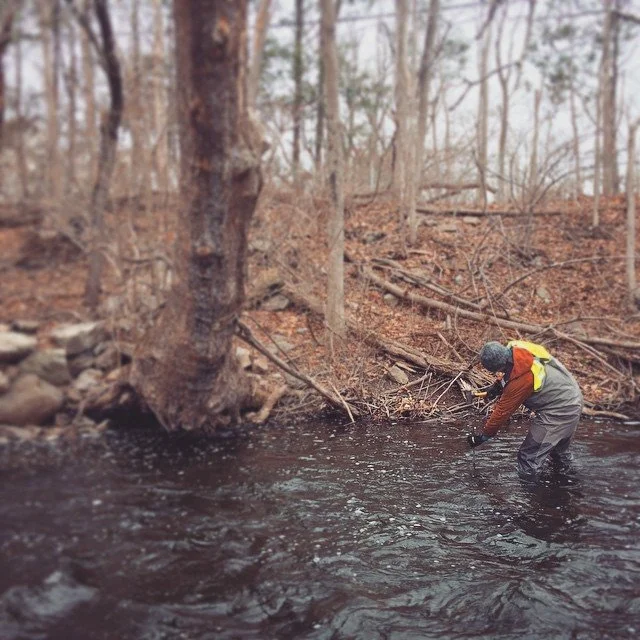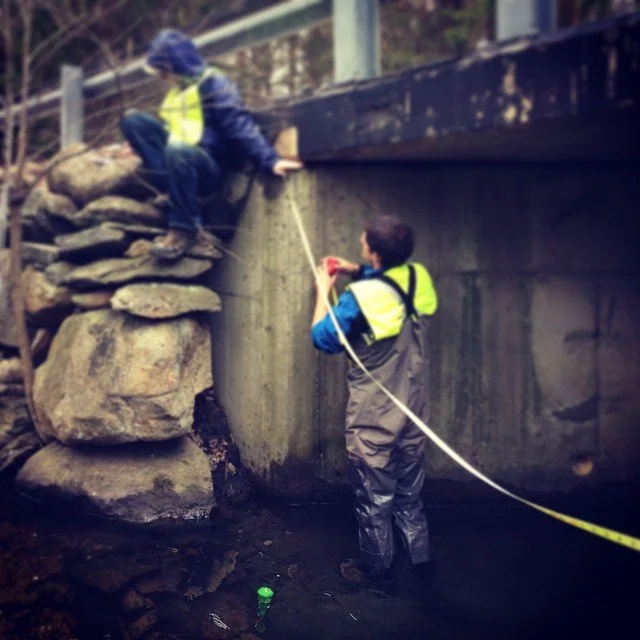Norwalk River Watershed Analysis
At One Nature, our guiding philosophy is rooted in the belief that watersheds are fundamental to the ecological identity of communities. They are living systems that define the health and character of the places where people live, work, and connect with environment. is rooted in the idea that landscapes can thrive as both human and ecological systems. Through thoughtful planning, informed by science and guided by the principles of restoration ecology, we strive to breathe new life into damaged environments. Our recent work on an unnamed tributary to the Norwalk River (referred to here as the “Unnamed Brook”) highlights this commitment. Partnering with the Mianus Chapter of Trout Unlimited, we undertook a detailed assessment of the brook to identify the challenges it faces and propose actionable solutions to restore its ecological function. This project represents not only a localized effort to restore one stream but also a critical step toward addressing the broader ecological challenges facing the Norwalk River watershed.
Prior to European colonization, the Norwalk River watershed was a pristine and thriving ecosystem. Indigenous peoples, including the Schaghticoke and other Algonquian-speaking tribes, lived in balance with the land, using sustainable practices to maintain the health of their surroundings. Rivers, including the Unnamed Brook, teemed with aquatic life, such as brook trout, shad, and salmon. These waterways were not only sources of sustenance but also sacred spaces that supported cultural and community life. The arrival of European settlers in the 17th century, however, brought profound changes. Forests were cleared for agriculture, wetlands were drained, and rivers were dammed to power mills. Over time, industrialization introduced pollutants into the waterways, while the growing demand for water led to the construction of reservoirs and diversion infrastructure. By the 20th century, these cumulative impacts had fundamentally altered the watershed, severely reducing its ability to support cold-water species and other forms of biodiversity. Today, remnants of these historical disruptions are visible throughout the Norwalk River watershed. The Unnamed Brook, once a robust cold-water stream capable of supporting brook trout populations, now suffers from reduced flow and elevated temperatures in its lower reaches. These changes have made it an inhospitable environment for the aquatic life it once supported.
The Mianus Chapter of Trout Unlimited approached One Nature to help address the ecological challenges facing the Unnamed Brook. For us, this project represented an opportunity to apply our expertise in ecological restoration to a site with significant historical and environmental importance. We began by assessing the brook’s hydrology and thermal profile, focusing particularly on the impact of a water intake facility that diverts a significant amount of flow from the brook. This facility, located between the brook’s upper and lower reaches, creates a stark contrast: while the upper reaches remain cool and flowing, the downstream sections are stagnant and warm, unable to sustain aquatic life. At One Nature, we approach every project with a commitment to rigorous, science-based methodologies. For the Unnamed Brook, we employed a range of tools and techniques to evaluate its ecological health. To gather reliable data, we established four gauging stations along the Unnamed Brook and two temperature monitoring sites on the Norwalk River. These stations were strategically positioned to measure the effects of the water intake facility and downstream flow patterns. Using HOBO Water Level Loggers and Temperature Loggers, we collected data on stream depth, flow, and temperature at 15-minute intervals from April to October 2015. The loggers were installed in areas with good water mixing and were regularly checked and calibrated during monthly site visits. To understand how the intake facility affected the brook’s flow, we measured stream velocity, depth, and discharge using USGS-recommended methods. This analysis revealed a significant reduction in downstream flow, particularly during dry periods. Lower flow rates corresponded with higher water temperatures, creating conditions unsuitable for cold-water species like brook trout.
Our findings confirmed that the Unnamed Brook faces significant ecological challenges. Its upper reaches, unaffected by the water intake facility, remain a thriving cold-water habitat. Here, the brook retains sufficient flow and temperatures conducive to brook trout and other aquatic life. However, the downstream sections tell a different story. Below the intake facility, the brook’s flow diminishes drastically, leaving behind stagnant pools and elevated temperatures. This transformation makes the lower reaches inhospitable for aquatic species, particularly during dry months when environmental inflows are low. The intake facility, which diverts water into a reservoir system, operates without an environmental management plan. This lack of oversight has allowed the facility to prioritize water withdrawals for human use at the expense of the brook’s ecological integrity. The downstream warming also affects the Norwalk River, contributing to thermal stress in this critical regional waterway.
At One Nature, we believe that restoration requires a holistic approach, balancing engineering solutions, ecological restoration, and community engagement. Based on our findings, we developed several recommendations to restore the Unnamed Brook. The water intake facility must be adapted to maintain minimum environmental flows downstream. This can be achieved by installing mechanisms that allow for consistent flow releases, ensuring that the brook’s lower reaches remain hydrated and ecologically functional. Riparian buffers are critical for maintaining water quality and regulating stream temperature. We recommend replanting the brook’s banks with native vegetation, which will provide shade, reduce sedimentation, and enhance habitat for wildlife. Restoring the brook’s floodplains and wetlands will improve its ability to absorb stormwater and maintain base flows during dry periods. These features are essential for long-term hydrological stability and biodiversity. Additionally, the entire Norwalk River watershed would benefit from a coordinated management plan that addresses water withdrawals, pollution, and land use. Such a plan would ensure that the needs of human communities and ecosystems are balanced. Engaging local residents, municipalities, and stakeholders is vital for the success of restoration efforts. Through public education initiatives, workshops, and partnerships, we aim to foster a sense of stewardship for the brook and its surrounding ecosystems. Restoration is also an iterative process that requires ongoing monitoring. We recommend establishing a long-term program to track flow rates, temperatures, and ecological health, allowing for adjustments as needed.
The restoration of the Unnamed Brook is about more than one stream; it is a step toward revitalizing the entire Norwalk River watershed. Cold-water species like brook trout are considered “umbrella species,” meaning their conservation benefits the broader ecosystem. By addressing the root causes of degradation in this brook, we can improve water quality, enhance biodiversity, and create a more resilient watershed. This project also serves as a model for ecological restoration in other regions. It demonstrates the importance of integrating scientific research, thoughtful design, and community engagement to achieve sustainable outcomes. As climate change exacerbates challenges like water scarcity and thermal stress, projects like this will become increasingly critical.
At One Nature, we approach every restoration project with a sense of responsibility and possibility. The Unnamed Brook, like many streams in the Norwalk River watershed, reflects the cumulative impacts of centuries of human activity. Yet, it also holds the potential for renewal. Through modifications to infrastructure, ecological restoration, and community collaboration, we believe this brook can be transformed into a thriving habitat once again. By doing so, we not only restore a single stream but also contribute to the health and resilience of an entire watershed. Our work on the Unnamed Brook reaffirms our belief that thoughtful planning and action can create a future where environmental and human systems coexist harmoniously.





